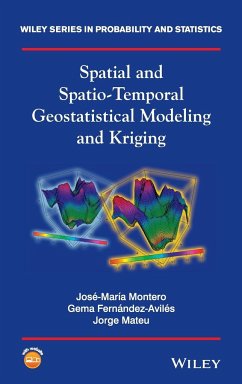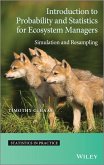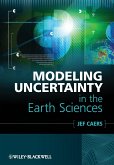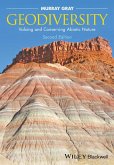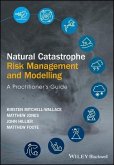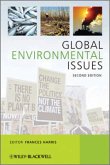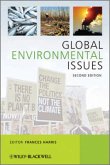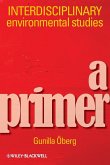José-Maria Montero, Gema Fernández-Avilés, Jorge Mateu
Spatial and Spatio-Temporal Geostatistical Modeling and Kriging
José-Maria Montero, Gema Fernández-Avilés, Jorge Mateu
Spatial and Spatio-Temporal Geostatistical Modeling and Kriging
- Gebundenes Buch
- Merkliste
- Auf die Merkliste
- Bewerten Bewerten
- Teilen
- Produkt teilen
- Produkterinnerung
- Produkterinnerung
Statistical Methods for Spatial and Spatio-Temporal Data Analysis provides a complete range of spatio-temporal covariance functions and discusses ways of constructing them. This book is a unified approach to modeling spatial and spatio-temporal data together with significant developments in statistical methodology with applications in R.
This book includes: * Methods for selecting valid covariance functions from the empirical counterparts that overcome the existing limitations of the traditional methods. * The most innovative developments in the different steps of the kriging process. * An…mehr
Andere Kunden interessierten sich auch für
![Introduction to Probability and Statistics for Ecosystem Managers Introduction to Probability and Statistics for Ecosystem Managers]() Timothy C. HaasIntroduction to Probability and Statistics for Ecosystem Managers93,99 €
Timothy C. HaasIntroduction to Probability and Statistics for Ecosystem Managers93,99 €![Modeling Uncertainty in the Earth Sciences Modeling Uncertainty in the Earth Sciences]() Jef CaersModeling Uncertainty in the Earth Sciences78,99 €
Jef CaersModeling Uncertainty in the Earth Sciences78,99 €![Geodiversity Geodiversity]() Murray GrayGeodiversity154,99 €
Murray GrayGeodiversity154,99 €![Natural Catastrophe Risk Management and Modelling Natural Catastrophe Risk Management and Modelling]() Kirsten Mitchell-WallaceNatural Catastrophe Risk Management and Modelling111,99 €
Kirsten Mitchell-WallaceNatural Catastrophe Risk Management and Modelling111,99 €![Global Environmental Issues Global Environmental Issues]() Global Environmental Issues79,99 €
Global Environmental Issues79,99 €![Global Environmental Issues Global Environmental Issues]() Global Environmental Issues151,99 €
Global Environmental Issues151,99 €![Interdisciplinary Environmental Studies Interdisciplinary Environmental Studies]() Gunilla ObergInterdisciplinary Environmental Studies61,99 €
Gunilla ObergInterdisciplinary Environmental Studies61,99 €-
-
-
Statistical Methods for Spatial and Spatio-Temporal Data Analysis provides a complete range of spatio-temporal covariance functions and discusses ways of constructing them. This book is a unified approach to modeling spatial and spatio-temporal data together with significant developments in statistical methodology with applications in R.
This book includes:
* Methods for selecting valid covariance functions from the empirical counterparts that overcome the existing limitations of the traditional methods.
* The most innovative developments in the different steps of the kriging process.
* An up-to-date account of strategies for dealing with data evolving in space and time.
* An accompanying website featuring R code and examples
This book includes:
* Methods for selecting valid covariance functions from the empirical counterparts that overcome the existing limitations of the traditional methods.
* The most innovative developments in the different steps of the kriging process.
* An up-to-date account of strategies for dealing with data evolving in space and time.
* An accompanying website featuring R code and examples
Produktdetails
- Produktdetails
- Wiley Series in Probability and Statistics
- Verlag: Wiley & Sons
- 1. Auflage
- Seitenzahl: 400
- Erscheinungstermin: 17. August 2015
- Englisch
- Abmessung: 235mm x 157mm x 27mm
- Gewicht: 666g
- ISBN-13: 9781118413180
- ISBN-10: 1118413180
- Artikelnr.: 38106584
- Herstellerkennzeichnung
- Libri GmbH
- Europaallee 1
- 36244 Bad Hersfeld
- gpsr@libri.de
- Wiley Series in Probability and Statistics
- Verlag: Wiley & Sons
- 1. Auflage
- Seitenzahl: 400
- Erscheinungstermin: 17. August 2015
- Englisch
- Abmessung: 235mm x 157mm x 27mm
- Gewicht: 666g
- ISBN-13: 9781118413180
- ISBN-10: 1118413180
- Artikelnr.: 38106584
- Herstellerkennzeichnung
- Libri GmbH
- Europaallee 1
- 36244 Bad Hersfeld
- gpsr@libri.de
José-María Montero and Gema Fernández-Avilés, Department of Statistics, University of Castilla-La Mancha, Spain Jorge Mateu, Department of Mathematics, University Jaume I of Castellon, Spain
List of figures xi
List of tables xvii
Foreword xix
Preface xxi
The companion website xxiii
1 From classical statistics to geostatistics 1
1.1 Not all spatial data are geostatistical data 1
1.2 The limits of classical statistics 5
1.3 A real geostatistical dataset: data on carbon monoxide in Madrid, Spain 7
2 Geostatistics: preliminaries 10
2.1 Regionalized variables 10
2.2 Random functions 11
2.3 Stationary and intrinsic hypotheses 13
2.3.1 Stationarity 13
2.3.2 Stationary random functions in the strict sense 14
2.3.3 Second-order stationary random functions 15
2.3.4 Intrinsically stationary random functions 16
2.3.5 Non-stationary random functions 18
2.4 Support 19
3 Structural analysis 20
3.1 Introduction 20
3.2 Covariance function 21
3.2.1 Definition and properties 21
3.2.2 Some theoretical isotropic covariance functions 23
3.3 Empirical covariogram 26
3.4 Semivariogram 27
3.4.1 Definition and properties 27
3.4.2 Behavior at intermediate and large distances 30
3.4.3 Behavior near the origin 31
3.4.4 A discontinuity at the origin 33
3.5 Theoretical semivariogram models 35
3.5.1 Semivariograms with a sill 36
3.5.2 Semivariograms with a hole effect 46
3.5.3 Semivariograms without a sill 47
3.5.4 Combining semivariogram models 50
3.6 Empirical semivariogram 52
3.7 Anisotropy 64
3.8 Fitting a semivariogram model 69
3.8.1 Manual fitting 70
3.8.2 Automatic fitting 71
4 Spatial prediction and kriging 80
4.1 Introduction 80
4.2 Neighborhood 83
4.3 Ordinary kriging 84
4.3.1 Point observation support and point predictor 84
4.3.2 Effects of a change in the model parameters 90
4.3.3 Point observation support and block predictor 99
4.3.4 Block observation support and block predictor 110
4.4 Simple kriging: the special case of known mean 113
4.5 Simple kriging with an estimated mean 115
4.6 Universal kriging 116
4.6.1 Point observation support and point predictor 116
4.6.2 Point observation support and block predictor 121
4.6.3 Block observation support and block predictor 121
4.6.4 Kriging and exact interpolation 122
4.7 Residual kriging 122
4.7.1 Direct residual kriging 123
4.7.2 Iterative residual kriging 124
4.7.3 Modified iterative residual kriging 125
4.8 Median-Polish kriging 125
4.9 Cross-validation 134
4.10 Non-linear kriging 138
4.10.1 Disjunctive kriging 138
4.10.2 Indicator kriging 142
5 Geostatistics and spatio-temporal random functions 145
5.1 Spatio-temporal geostatistics 145
5.2 Spatio-temporal continuity 146
5.3 Relevant spatio-temporal concepts 147
5.4 Properties of the spatio-temporal covariance and semivariogram 157
6 Spatio-temporal structural analysis (I): empirical semivariogram
and covariogram estimation and model fitting 162
6.1 Introduction 162
6.2 The empirical spatio-temporal semivariogram and covariogram 163
6.3 Fitting spatio-temporal semivariogram and covariogram models 170
6.4 Validation and comparison of spatio-temporal semivariogram and covariogram models 174
7 Spatio-temporal structural analysis (II): theoretical covariance models 178
7.1 Introduction 178
7.2 Combined distance or metric model 180
7.3 Sum model 183
7.4 Combined metric-sum model 184
7.5 Product model 187
7.6 Product-sum model 191
7.7 Porcu and Mateu mixture-based models 192
7.8 General product-sum model 194
7.9 Integrated product and product-sum models 198
7.10 Models proposed by Cressie and Huang 201
7.11 Models proposed by Gneiting 207
7.12 Mixture models proposed by Ma 211
7.12.1 Covariance functions generated by scale mixtures 211
7.12.2 Covariance functions generated by positive power mixtures 212
7.13 Models generated by linear combinations proposed by Ma 215
7.14 Models proposed by Stein 222
7.15 Construction of covariance functions using copulas and completely monotonic functions 223
7.16 Generalized product-sum model 223
7.17 Models that are not fully symmetric 236
7.18 Mixture-based Bernstein zonally anisotropic covariance functions 237
7.19 Non-stationary models 241
7.19.1 Mixture of locally orthogonal stationary processes 241
7.19.2 Non-stationary models proposed by Ma 242
7.19.3 Non-stationary models proposed by Porcu and Mateu 246
7.20 Anisotropic covariance functions by Porcu and Mateu 247
7.20.1 Constructing temporally symmetric and spatially anisotropic covariance functions 247
7.20.2 Generalizing the class of spatio-temporal covariance functions proposed by Gneiting 248
7.20.3 Differentiation and integration operators acting on classes of anisotropic covariance functions on the basis of isotropic components: 'La descente &##;tendue' 251
7.21 Spatio-temporal constructions based on quasi-arithmetic means of covariance functions 253
7.21.1 Multivariate quasi-arithmetic compositions 255
7.21.2 Permissibility criteria for quasi-arithmetic means of covariance functions in Rd 256
7.21.3 The use of quasi-arithmetic functionals to build non-separable, stationary, spatio-temporal covariance functions 259
7.21.4 Quasi-arithmeticity and non-stationarity in space 264
8 Spatio-temporal prediction and kriging 266
8.1 Spatio-temporal kriging 266
8.2 Spatio-temporal kriging equations 267
9 An introduction to functional geostatistics 274
9.1 Functional data analysis 274
9.2 Functional geostatistics: The parametric vs. the non-parametric approach 279
9.3 Functional ordinary kriging 283
9.3.1 Preliminaries 283
9.3.2 Functional ordinary kriging equations 284
9.3.3 Estimating the trace-semivariogram 288
9.3.4 Functional cross-validation 289
A Spectral representations 295
B Probabilistic aspects of Uij = Z(si).Z(sj) 300
C Basic theory on restricted maximum likelihood 302
D Most relevant proofs 304
Bibliography and further reading 327
Index 351
List of tables xvii
Foreword xix
Preface xxi
The companion website xxiii
1 From classical statistics to geostatistics 1
1.1 Not all spatial data are geostatistical data 1
1.2 The limits of classical statistics 5
1.3 A real geostatistical dataset: data on carbon monoxide in Madrid, Spain 7
2 Geostatistics: preliminaries 10
2.1 Regionalized variables 10
2.2 Random functions 11
2.3 Stationary and intrinsic hypotheses 13
2.3.1 Stationarity 13
2.3.2 Stationary random functions in the strict sense 14
2.3.3 Second-order stationary random functions 15
2.3.4 Intrinsically stationary random functions 16
2.3.5 Non-stationary random functions 18
2.4 Support 19
3 Structural analysis 20
3.1 Introduction 20
3.2 Covariance function 21
3.2.1 Definition and properties 21
3.2.2 Some theoretical isotropic covariance functions 23
3.3 Empirical covariogram 26
3.4 Semivariogram 27
3.4.1 Definition and properties 27
3.4.2 Behavior at intermediate and large distances 30
3.4.3 Behavior near the origin 31
3.4.4 A discontinuity at the origin 33
3.5 Theoretical semivariogram models 35
3.5.1 Semivariograms with a sill 36
3.5.2 Semivariograms with a hole effect 46
3.5.3 Semivariograms without a sill 47
3.5.4 Combining semivariogram models 50
3.6 Empirical semivariogram 52
3.7 Anisotropy 64
3.8 Fitting a semivariogram model 69
3.8.1 Manual fitting 70
3.8.2 Automatic fitting 71
4 Spatial prediction and kriging 80
4.1 Introduction 80
4.2 Neighborhood 83
4.3 Ordinary kriging 84
4.3.1 Point observation support and point predictor 84
4.3.2 Effects of a change in the model parameters 90
4.3.3 Point observation support and block predictor 99
4.3.4 Block observation support and block predictor 110
4.4 Simple kriging: the special case of known mean 113
4.5 Simple kriging with an estimated mean 115
4.6 Universal kriging 116
4.6.1 Point observation support and point predictor 116
4.6.2 Point observation support and block predictor 121
4.6.3 Block observation support and block predictor 121
4.6.4 Kriging and exact interpolation 122
4.7 Residual kriging 122
4.7.1 Direct residual kriging 123
4.7.2 Iterative residual kriging 124
4.7.3 Modified iterative residual kriging 125
4.8 Median-Polish kriging 125
4.9 Cross-validation 134
4.10 Non-linear kriging 138
4.10.1 Disjunctive kriging 138
4.10.2 Indicator kriging 142
5 Geostatistics and spatio-temporal random functions 145
5.1 Spatio-temporal geostatistics 145
5.2 Spatio-temporal continuity 146
5.3 Relevant spatio-temporal concepts 147
5.4 Properties of the spatio-temporal covariance and semivariogram 157
6 Spatio-temporal structural analysis (I): empirical semivariogram
and covariogram estimation and model fitting 162
6.1 Introduction 162
6.2 The empirical spatio-temporal semivariogram and covariogram 163
6.3 Fitting spatio-temporal semivariogram and covariogram models 170
6.4 Validation and comparison of spatio-temporal semivariogram and covariogram models 174
7 Spatio-temporal structural analysis (II): theoretical covariance models 178
7.1 Introduction 178
7.2 Combined distance or metric model 180
7.3 Sum model 183
7.4 Combined metric-sum model 184
7.5 Product model 187
7.6 Product-sum model 191
7.7 Porcu and Mateu mixture-based models 192
7.8 General product-sum model 194
7.9 Integrated product and product-sum models 198
7.10 Models proposed by Cressie and Huang 201
7.11 Models proposed by Gneiting 207
7.12 Mixture models proposed by Ma 211
7.12.1 Covariance functions generated by scale mixtures 211
7.12.2 Covariance functions generated by positive power mixtures 212
7.13 Models generated by linear combinations proposed by Ma 215
7.14 Models proposed by Stein 222
7.15 Construction of covariance functions using copulas and completely monotonic functions 223
7.16 Generalized product-sum model 223
7.17 Models that are not fully symmetric 236
7.18 Mixture-based Bernstein zonally anisotropic covariance functions 237
7.19 Non-stationary models 241
7.19.1 Mixture of locally orthogonal stationary processes 241
7.19.2 Non-stationary models proposed by Ma 242
7.19.3 Non-stationary models proposed by Porcu and Mateu 246
7.20 Anisotropic covariance functions by Porcu and Mateu 247
7.20.1 Constructing temporally symmetric and spatially anisotropic covariance functions 247
7.20.2 Generalizing the class of spatio-temporal covariance functions proposed by Gneiting 248
7.20.3 Differentiation and integration operators acting on classes of anisotropic covariance functions on the basis of isotropic components: 'La descente &##;tendue' 251
7.21 Spatio-temporal constructions based on quasi-arithmetic means of covariance functions 253
7.21.1 Multivariate quasi-arithmetic compositions 255
7.21.2 Permissibility criteria for quasi-arithmetic means of covariance functions in Rd 256
7.21.3 The use of quasi-arithmetic functionals to build non-separable, stationary, spatio-temporal covariance functions 259
7.21.4 Quasi-arithmeticity and non-stationarity in space 264
8 Spatio-temporal prediction and kriging 266
8.1 Spatio-temporal kriging 266
8.2 Spatio-temporal kriging equations 267
9 An introduction to functional geostatistics 274
9.1 Functional data analysis 274
9.2 Functional geostatistics: The parametric vs. the non-parametric approach 279
9.3 Functional ordinary kriging 283
9.3.1 Preliminaries 283
9.3.2 Functional ordinary kriging equations 284
9.3.3 Estimating the trace-semivariogram 288
9.3.4 Functional cross-validation 289
A Spectral representations 295
B Probabilistic aspects of Uij = Z(si).Z(sj) 300
C Basic theory on restricted maximum likelihood 302
D Most relevant proofs 304
Bibliography and further reading 327
Index 351
List of figures xi
List of tables xvii
Foreword xix
Preface xxi
The companion website xxiii
1 From classical statistics to geostatistics 1
1.1 Not all spatial data are geostatistical data 1
1.2 The limits of classical statistics 5
1.3 A real geostatistical dataset: data on carbon monoxide in Madrid, Spain 7
2 Geostatistics: preliminaries 10
2.1 Regionalized variables 10
2.2 Random functions 11
2.3 Stationary and intrinsic hypotheses 13
2.3.1 Stationarity 13
2.3.2 Stationary random functions in the strict sense 14
2.3.3 Second-order stationary random functions 15
2.3.4 Intrinsically stationary random functions 16
2.3.5 Non-stationary random functions 18
2.4 Support 19
3 Structural analysis 20
3.1 Introduction 20
3.2 Covariance function 21
3.2.1 Definition and properties 21
3.2.2 Some theoretical isotropic covariance functions 23
3.3 Empirical covariogram 26
3.4 Semivariogram 27
3.4.1 Definition and properties 27
3.4.2 Behavior at intermediate and large distances 30
3.4.3 Behavior near the origin 31
3.4.4 A discontinuity at the origin 33
3.5 Theoretical semivariogram models 35
3.5.1 Semivariograms with a sill 36
3.5.2 Semivariograms with a hole effect 46
3.5.3 Semivariograms without a sill 47
3.5.4 Combining semivariogram models 50
3.6 Empirical semivariogram 52
3.7 Anisotropy 64
3.8 Fitting a semivariogram model 69
3.8.1 Manual fitting 70
3.8.2 Automatic fitting 71
4 Spatial prediction and kriging 80
4.1 Introduction 80
4.2 Neighborhood 83
4.3 Ordinary kriging 84
4.3.1 Point observation support and point predictor 84
4.3.2 Effects of a change in the model parameters 90
4.3.3 Point observation support and block predictor 99
4.3.4 Block observation support and block predictor 110
4.4 Simple kriging: the special case of known mean 113
4.5 Simple kriging with an estimated mean 115
4.6 Universal kriging 116
4.6.1 Point observation support and point predictor 116
4.6.2 Point observation support and block predictor 121
4.6.3 Block observation support and block predictor 121
4.6.4 Kriging and exact interpolation 122
4.7 Residual kriging 122
4.7.1 Direct residual kriging 123
4.7.2 Iterative residual kriging 124
4.7.3 Modified iterative residual kriging 125
4.8 Median-Polish kriging 125
4.9 Cross-validation 134
4.10 Non-linear kriging 138
4.10.1 Disjunctive kriging 138
4.10.2 Indicator kriging 142
5 Geostatistics and spatio-temporal random functions 145
5.1 Spatio-temporal geostatistics 145
5.2 Spatio-temporal continuity 146
5.3 Relevant spatio-temporal concepts 147
5.4 Properties of the spatio-temporal covariance and semivariogram 157
6 Spatio-temporal structural analysis (I): empirical semivariogram
and covariogram estimation and model fitting 162
6.1 Introduction 162
6.2 The empirical spatio-temporal semivariogram and covariogram 163
6.3 Fitting spatio-temporal semivariogram and covariogram models 170
6.4 Validation and comparison of spatio-temporal semivariogram and covariogram models 174
7 Spatio-temporal structural analysis (II): theoretical covariance models 178
7.1 Introduction 178
7.2 Combined distance or metric model 180
7.3 Sum model 183
7.4 Combined metric-sum model 184
7.5 Product model 187
7.6 Product-sum model 191
7.7 Porcu and Mateu mixture-based models 192
7.8 General product-sum model 194
7.9 Integrated product and product-sum models 198
7.10 Models proposed by Cressie and Huang 201
7.11 Models proposed by Gneiting 207
7.12 Mixture models proposed by Ma 211
7.12.1 Covariance functions generated by scale mixtures 211
7.12.2 Covariance functions generated by positive power mixtures 212
7.13 Models generated by linear combinations proposed by Ma 215
7.14 Models proposed by Stein 222
7.15 Construction of covariance functions using copulas and completely monotonic functions 223
7.16 Generalized product-sum model 223
7.17 Models that are not fully symmetric 236
7.18 Mixture-based Bernstein zonally anisotropic covariance functions 237
7.19 Non-stationary models 241
7.19.1 Mixture of locally orthogonal stationary processes 241
7.19.2 Non-stationary models proposed by Ma 242
7.19.3 Non-stationary models proposed by Porcu and Mateu 246
7.20 Anisotropic covariance functions by Porcu and Mateu 247
7.20.1 Constructing temporally symmetric and spatially anisotropic covariance functions 247
7.20.2 Generalizing the class of spatio-temporal covariance functions proposed by Gneiting 248
7.20.3 Differentiation and integration operators acting on classes of anisotropic covariance functions on the basis of isotropic components: 'La descente &##;tendue' 251
7.21 Spatio-temporal constructions based on quasi-arithmetic means of covariance functions 253
7.21.1 Multivariate quasi-arithmetic compositions 255
7.21.2 Permissibility criteria for quasi-arithmetic means of covariance functions in Rd 256
7.21.3 The use of quasi-arithmetic functionals to build non-separable, stationary, spatio-temporal covariance functions 259
7.21.4 Quasi-arithmeticity and non-stationarity in space 264
8 Spatio-temporal prediction and kriging 266
8.1 Spatio-temporal kriging 266
8.2 Spatio-temporal kriging equations 267
9 An introduction to functional geostatistics 274
9.1 Functional data analysis 274
9.2 Functional geostatistics: The parametric vs. the non-parametric approach 279
9.3 Functional ordinary kriging 283
9.3.1 Preliminaries 283
9.3.2 Functional ordinary kriging equations 284
9.3.3 Estimating the trace-semivariogram 288
9.3.4 Functional cross-validation 289
A Spectral representations 295
B Probabilistic aspects of Uij = Z(si).Z(sj) 300
C Basic theory on restricted maximum likelihood 302
D Most relevant proofs 304
Bibliography and further reading 327
Index 351
List of tables xvii
Foreword xix
Preface xxi
The companion website xxiii
1 From classical statistics to geostatistics 1
1.1 Not all spatial data are geostatistical data 1
1.2 The limits of classical statistics 5
1.3 A real geostatistical dataset: data on carbon monoxide in Madrid, Spain 7
2 Geostatistics: preliminaries 10
2.1 Regionalized variables 10
2.2 Random functions 11
2.3 Stationary and intrinsic hypotheses 13
2.3.1 Stationarity 13
2.3.2 Stationary random functions in the strict sense 14
2.3.3 Second-order stationary random functions 15
2.3.4 Intrinsically stationary random functions 16
2.3.5 Non-stationary random functions 18
2.4 Support 19
3 Structural analysis 20
3.1 Introduction 20
3.2 Covariance function 21
3.2.1 Definition and properties 21
3.2.2 Some theoretical isotropic covariance functions 23
3.3 Empirical covariogram 26
3.4 Semivariogram 27
3.4.1 Definition and properties 27
3.4.2 Behavior at intermediate and large distances 30
3.4.3 Behavior near the origin 31
3.4.4 A discontinuity at the origin 33
3.5 Theoretical semivariogram models 35
3.5.1 Semivariograms with a sill 36
3.5.2 Semivariograms with a hole effect 46
3.5.3 Semivariograms without a sill 47
3.5.4 Combining semivariogram models 50
3.6 Empirical semivariogram 52
3.7 Anisotropy 64
3.8 Fitting a semivariogram model 69
3.8.1 Manual fitting 70
3.8.2 Automatic fitting 71
4 Spatial prediction and kriging 80
4.1 Introduction 80
4.2 Neighborhood 83
4.3 Ordinary kriging 84
4.3.1 Point observation support and point predictor 84
4.3.2 Effects of a change in the model parameters 90
4.3.3 Point observation support and block predictor 99
4.3.4 Block observation support and block predictor 110
4.4 Simple kriging: the special case of known mean 113
4.5 Simple kriging with an estimated mean 115
4.6 Universal kriging 116
4.6.1 Point observation support and point predictor 116
4.6.2 Point observation support and block predictor 121
4.6.3 Block observation support and block predictor 121
4.6.4 Kriging and exact interpolation 122
4.7 Residual kriging 122
4.7.1 Direct residual kriging 123
4.7.2 Iterative residual kriging 124
4.7.3 Modified iterative residual kriging 125
4.8 Median-Polish kriging 125
4.9 Cross-validation 134
4.10 Non-linear kriging 138
4.10.1 Disjunctive kriging 138
4.10.2 Indicator kriging 142
5 Geostatistics and spatio-temporal random functions 145
5.1 Spatio-temporal geostatistics 145
5.2 Spatio-temporal continuity 146
5.3 Relevant spatio-temporal concepts 147
5.4 Properties of the spatio-temporal covariance and semivariogram 157
6 Spatio-temporal structural analysis (I): empirical semivariogram
and covariogram estimation and model fitting 162
6.1 Introduction 162
6.2 The empirical spatio-temporal semivariogram and covariogram 163
6.3 Fitting spatio-temporal semivariogram and covariogram models 170
6.4 Validation and comparison of spatio-temporal semivariogram and covariogram models 174
7 Spatio-temporal structural analysis (II): theoretical covariance models 178
7.1 Introduction 178
7.2 Combined distance or metric model 180
7.3 Sum model 183
7.4 Combined metric-sum model 184
7.5 Product model 187
7.6 Product-sum model 191
7.7 Porcu and Mateu mixture-based models 192
7.8 General product-sum model 194
7.9 Integrated product and product-sum models 198
7.10 Models proposed by Cressie and Huang 201
7.11 Models proposed by Gneiting 207
7.12 Mixture models proposed by Ma 211
7.12.1 Covariance functions generated by scale mixtures 211
7.12.2 Covariance functions generated by positive power mixtures 212
7.13 Models generated by linear combinations proposed by Ma 215
7.14 Models proposed by Stein 222
7.15 Construction of covariance functions using copulas and completely monotonic functions 223
7.16 Generalized product-sum model 223
7.17 Models that are not fully symmetric 236
7.18 Mixture-based Bernstein zonally anisotropic covariance functions 237
7.19 Non-stationary models 241
7.19.1 Mixture of locally orthogonal stationary processes 241
7.19.2 Non-stationary models proposed by Ma 242
7.19.3 Non-stationary models proposed by Porcu and Mateu 246
7.20 Anisotropic covariance functions by Porcu and Mateu 247
7.20.1 Constructing temporally symmetric and spatially anisotropic covariance functions 247
7.20.2 Generalizing the class of spatio-temporal covariance functions proposed by Gneiting 248
7.20.3 Differentiation and integration operators acting on classes of anisotropic covariance functions on the basis of isotropic components: 'La descente &##;tendue' 251
7.21 Spatio-temporal constructions based on quasi-arithmetic means of covariance functions 253
7.21.1 Multivariate quasi-arithmetic compositions 255
7.21.2 Permissibility criteria for quasi-arithmetic means of covariance functions in Rd 256
7.21.3 The use of quasi-arithmetic functionals to build non-separable, stationary, spatio-temporal covariance functions 259
7.21.4 Quasi-arithmeticity and non-stationarity in space 264
8 Spatio-temporal prediction and kriging 266
8.1 Spatio-temporal kriging 266
8.2 Spatio-temporal kriging equations 267
9 An introduction to functional geostatistics 274
9.1 Functional data analysis 274
9.2 Functional geostatistics: The parametric vs. the non-parametric approach 279
9.3 Functional ordinary kriging 283
9.3.1 Preliminaries 283
9.3.2 Functional ordinary kriging equations 284
9.3.3 Estimating the trace-semivariogram 288
9.3.4 Functional cross-validation 289
A Spectral representations 295
B Probabilistic aspects of Uij = Z(si).Z(sj) 300
C Basic theory on restricted maximum likelihood 302
D Most relevant proofs 304
Bibliography and further reading 327
Index 351

